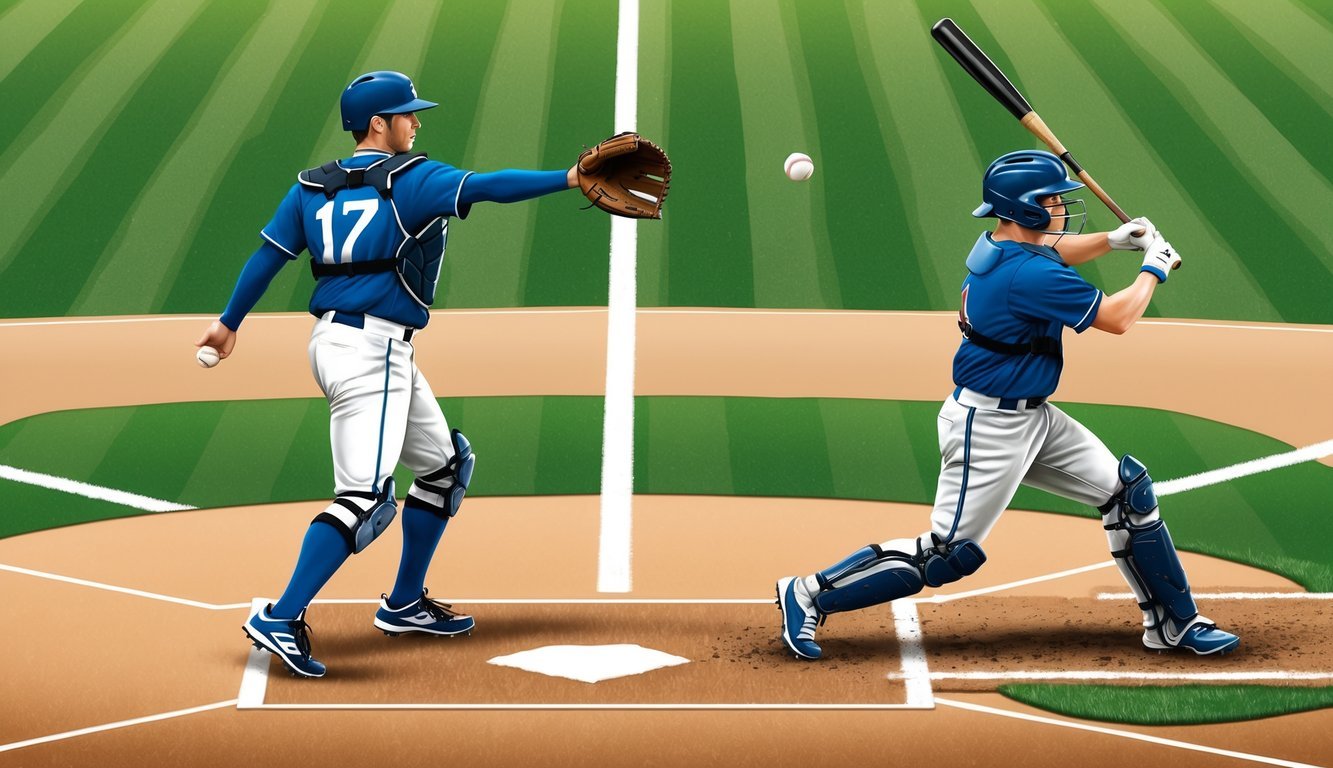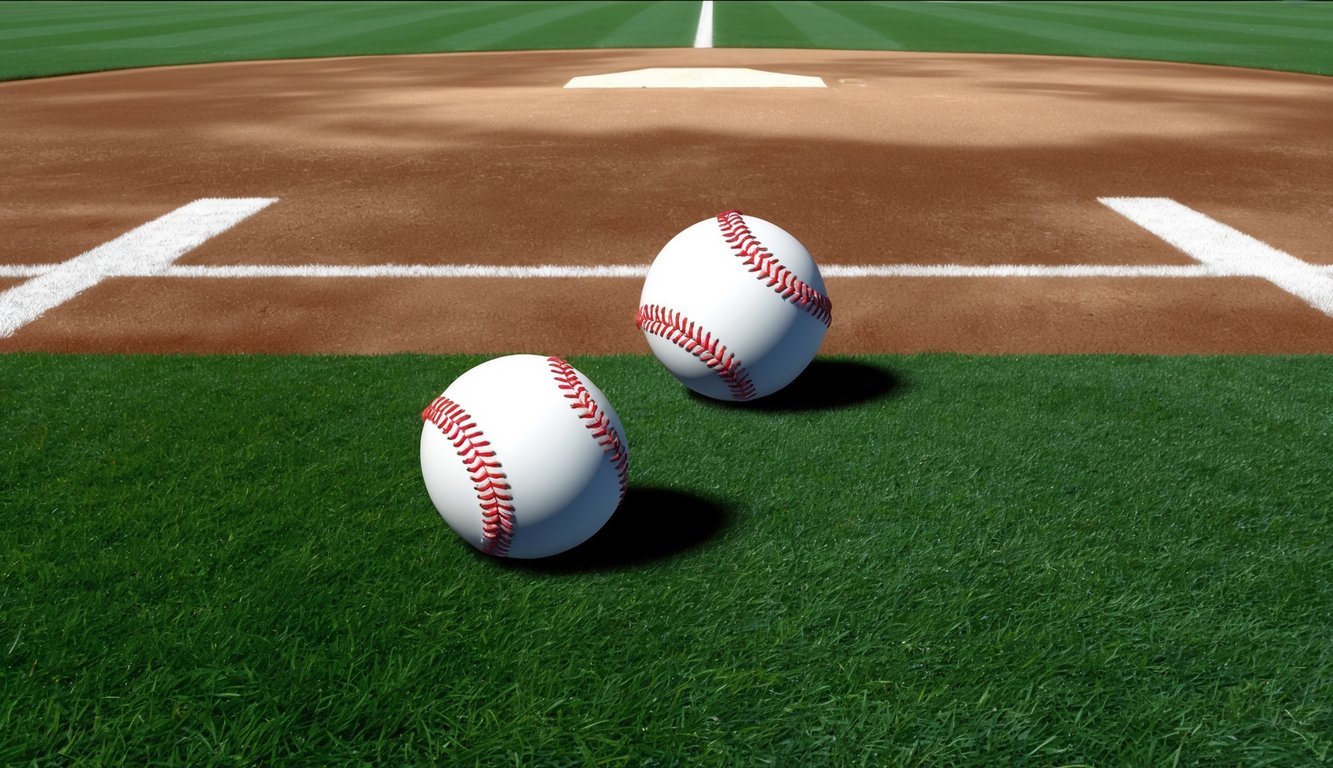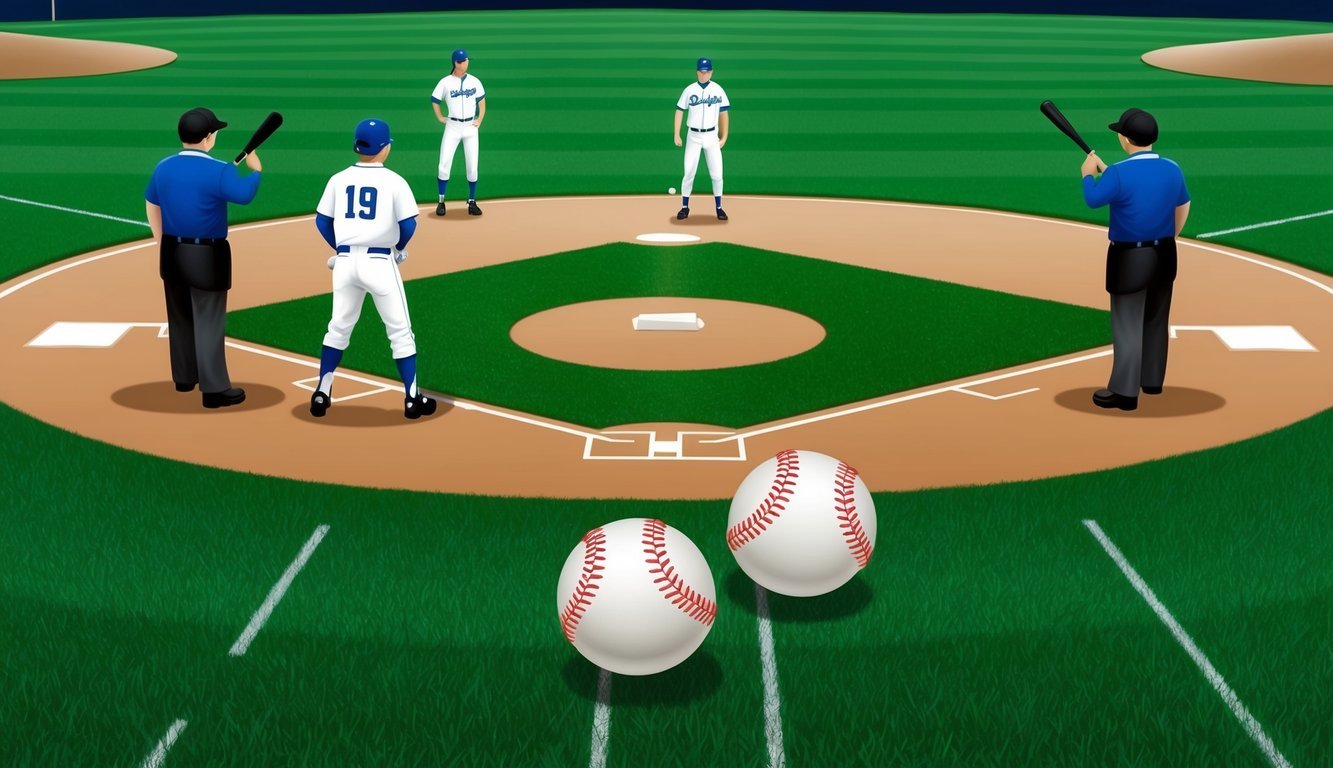Baseball fans often wonder about the finer details of America’s favorite pastime.
One intriguing question that arises is how many baseballs are actually used during a Major League Baseball (MLB) game.
The average MLB game uses between 84 to 120 baseballs. This surprising number is due to various factors such as foul balls, home runs, and balls that become scuffed or damaged during play.
Umpires are vigilant about replacing balls that show signs of wear, ensuring the integrity of each pitch.
Teams and the league go through an astounding number of baseballs over the course of a season.
With 30 teams playing 162 games each, plus playoffs and practice sessions, the total can reach upwards of 900,000 baseballs per year.
This high turnover rate keeps Rawlings, the official baseball supplier for MLB, very busy producing the iconic white spheres with red stitching that are crucial to the game.
The Role of Baseballs in MLB Games
Baseballs are the heart of every Major League game.
They impact pitching, hitting, and fielding while also creating lasting memories for fans.
Manufacturing and Preparation
Rawlings produces all official MLB baseballs to exacting standards.
Each ball contains a cork center wrapped in yarn and leather.
Before games, baseballs undergo special preparation.
Umpires or clubhouse attendants rub each ball with mud from a secret location on the Delaware River.
This process removes the factory shine and improves grip.
The mud-rubbing tradition dates back to the 1930s.
Baseballs are stored in climate-controlled rooms to maintain consistency.
Humidity can affect their weight and behavior during play.
Teams keep dozens of balls ready for each game.
On-Field Usage
MLB games typically use 84-120 baseballs.
Pitchers and catchers frequently request new balls.
Meanwhile, foul balls, home runs, and scuffed balls lead to replacements.
Umpires inspect balls regularly during play.
They check for damage or alterations that could affect performance.
A single pitch can result in a new ball if it hits the dirt or gets marked up.
Practice balls allow players to warm up without using game balls.
These may be slightly lower quality or previously used in games.
Batting practice alone can use dozens of balls.
Postgame and Memorabilia
Game-used baseballs often become prized memorabilia.
Milestone home run balls or no-hitters create valuable keepsakes for fans and players alike.
Teams may sell authenticated game balls in their shops.
Players frequently sign baseballs for charity auctions or fan giveaways.
Autographed baseballs are popular collectibles.
Some used balls get recycled for batting practice or minor league games.
Others may be donated to youth leagues or baseball camps.
This extends the life and impact of each MLB baseball.
How Many Baseballs Are Used?
MLB games churn through baseballs at a surprising rate.
The number used varies depending on game circumstances, but it’s much higher than most fans realize.
Average Number in Regular Season
A typical MLB game uses between 84 to 120 baseballs.
This high turnover stems from various factors during play.
Foul balls often end up in the stands, never to return.
Meanwhile, home runs also remove balls from circulation.
Umpires frequently replace scuffed or dirty balls to maintain consistent playing conditions.
Even slightly damaged balls get swapped out.
On average, a single game burns through about 100 baseballs.
Over a full 162-game season, one team might use up to 16,200 baseballs just for games.
Multiply that by 30 MLB teams, and you’re looking at nearly half a million baseballs per season.
Factors Affecting Baseball Usage
Weather plays a big role in baseball consumption.
Rainy conditions lead to more frequent ball changes.
Meanwhile, cold weather can make balls harder, prompting more replacements.
Pitching styles impact usage too.
Pitchers who frequently throw in the dirt cause more ball changes.
Similarly, power pitchers who generate a lot of foul balls also increase the turnover rate.
Stadium design matters as well.
Parks with more foul territory tend to keep balls in play longer.
On the other hand, those with tighter foul areas see more balls leave the field of play.
Team preferences also factor in.
Some clubs are more liberal with ball changes, while others try to conserve when possible.
Extra Innings and Playoff Impact
Extra-inning games naturally use more baseballs.
Each additional inning might require 10-15 more balls.
A marathon 18-inning game could easily surpass 150 baseballs used.
Playoff games often see higher usage rates.
The stakes are higher, so umpires are even more likely to swap out balls at the slightest imperfection.
World Series games top the charts for baseball consumption.
The excitement leads to more foul balls into the crowd.
Plus, MLB wants every pitch to be perfect, so they’re quick to replace any ball that’s less than pristine.
Minor league games typically use fewer balls, as they operate on tighter budgets.
But even there, dozens of baseballs get cycled through each game.
Lifecycle of a Baseball

Baseballs go through a fascinating journey from creation to retirement.
Their path involves rigorous quality checks, on-field action, and potential repurposing after use.
From the Factory to the Field
MLB baseballs start life in a factory where skilled workers craft them to exacting standards.
The core consists of a cork center wrapped in layers of rubber and wool yarn.
A leather cover is then stitched on by hand, with 108 double stitches creating the iconic red seams.
Before shipping, each ball undergoes strict quality control.
They’re tested for weight, size, and bounce to ensure consistency.
Once approved, the balls are packaged and sent to MLB stadiums.
Upon arrival, clubhouse staff prepare the balls for game use.
They rub each one with special mud from the Delaware River to remove the factory shine and improve grip.
Wear and Replacement
During a game, baseballs face constant wear and tear.
Pitches, hits, and fielding all take their toll.
Dirt, grass stains, and scuff marks accumulate quickly.
Umpires and players constantly check ball condition.
Any sign of damage or excessive wear leads to immediate replacement.
This ensures fair play and maintains pitcher control.
On average, a baseball’s in-game lifespan is just a few pitches.
Meanwhile, foul balls, home runs, and balls hit out of play are all removed from the game.
Even slightly marked balls often get swapped out.
Repurposing Used Baseballs
Baseballs removed from MLB games don’t go to waste.
Many find new life in various ways:
- Practice balls for batting practice and fielding drills
- Autograph balls for fan giveaways and charity events
- Sale as game-used memorabilia for collectors
- Donation to youth leagues and baseball development programs
Some teams even use retired balls for creative projects.
They might become part of stadium art installations or be recycled into new products.
Balls too damaged for reuse are often dismantled.
The yarn can be recycled, while the leather might find use in other products.
Cost and Supply Chain

The baseball supply chain involves significant costs and logistics for Major League Baseball.
From sourcing raw materials to manufacturing and distribution, each step contributes to the overall expense of providing high-quality baseballs for games.
Cost of Baseballs to MLB Teams
MLB teams spend millions annually on baseballs.
Each official MLB baseball costs around $7.
With 84-120 balls used per game, teams can spend $600-$840 per game just on baseballs.
Over a 162-game season, this adds up quickly.
Factor in practice sessions, warm-ups, and lost or damaged balls, and the total annual cost becomes even more staggering.
While teams manage these expenses as part of their overall budgets, other costs, such as umpire salaries, also play a significant role in league expenditures.
For those interested, an MLB umpire salary breakdown reveals how much officials earn for managing the game fairly and efficiently.
The league’s total annual expenditure on baseballs ranges from $3-4 million.
This investment ensures a steady supply of top-quality balls for all games and practices.
Minor league affiliates also require baseballs, though they use less expensive versions.
Still, the cost across all levels of professional baseball is substantial.
Sourcing Materials and Manufacturing
The production of MLB baseballs involves carefully selected materials from specific sources:
- Cowhides: Sourced from Tennessee Tanning and a Cargill’s beef plant in Pennsylvania
- Wool yarn: Imported from China
- Cork centers: Made in Mississippi
- Rubber: Shipped from Costa Rica
Strict quality control measures ensure consistency in leather quality and overall ball performance.
Rawlings, the official baseball supplier for MLB, manufactures the balls in Costa Rica.
Distribution and Availability
MLB maintains a robust distribution network to ensure baseballs are always available when needed.
Balls are shipped from Costa Rica to MLB warehouses in the United States.
From there, they’re distributed to all 30 MLB stadiums and minor league facilities.
Teams keep a large inventory on hand to meet game and practice needs.
Shipping costs are a significant factor, especially for rush orders during unexpected shortages.
MLB plans carefully to avoid such situations, balancing inventory levels with demand forecasts.
The league also considers environmental factors, implementing recycling programs for used baseballs when possible.
This helps offset some costs and reduces waste.
Significance and Rules

The frequent replacement of baseballs during MLB games serves crucial purposes for fairness, consistency, and player safety.
These practices are governed by strict league regulations and overseen by umpires to maintain the integrity of the sport.
Maintaining Fairness in the Game
MLB prioritizes fairness by replacing baseballs that become scuffed or damaged.
This prevents pitchers from gaining unfair advantages.
Umpires closely monitor ball condition, swapping out any that show signs of wear.
Batters and fielders also benefit from using balls in optimal condition.
Fresh baseballs ensure consistent performance for hitting and catching.
This level playing field is essential for the competitive nature of professional baseball.
Regular ball changes also help pitchers maintain their grip, especially in varying weather conditions.
This promotes safety and allows players to perform at their best throughout the game.
Regulations for Baseball Conditions
MLB has strict guidelines for baseball preparation and use.
Balls must meet specific size, weight, and composition standards.
Before each game, they’re rubbed with a special mud to remove shine and improve grip.
Umpires inspect balls regularly during play.
They look for signs of tampering or excessive wear.
Any ball that hits the dirt is typically replaced to maintain consistency.
Weather conditions can impact ball performance.
In humid environments, balls may be stored in climate-controlled areas to prevent moisture absorption.
This helps ensure uniform play across different stadiums and climates.
League Standards and Inspections
MLB enforces rigorous quality control measures for all game balls.
Each ball undergoes thorough inspection before being approved for use.
This process includes checking size and weight, verifying cork center integrity, and examining leather quality and stitching.
League officials conduct random inspections throughout the season.
They test balls from various games to ensure ongoing compliance with standards.
Any attempts to alter baseballs are met with severe penalties.
This strict oversight helps maintain the sport’s integrity and ensures fair competition across all teams and players.
